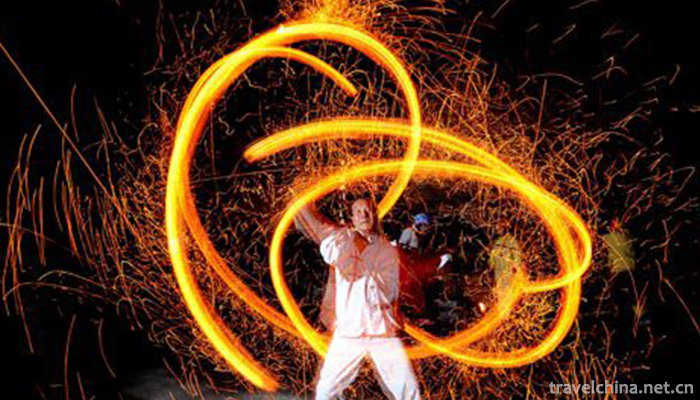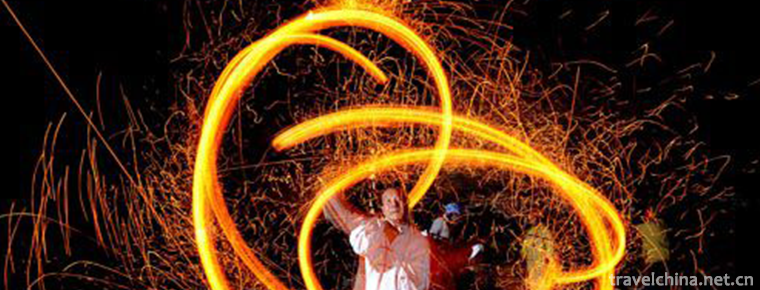Wind and Fire Meteor
Wind and Fire Meteor
Fenghuo Meteor is a traditional folk performing art which combines acrobatics and martial arts. It is one of the first intangible cultural heritages in Shanxi Province. It was selected into the second batch of national intangible cultural heritage list published by the State Council.
On June 7, 2008, Fenghuo Meteor was approved by the State Council to be included in the second batch of national intangible cultural heritage list.
The origin of Art
It is impossible to verify when and where the meteors originated. Some people say that it originated from the traditional folk acrobatics meteor; others say that it originated from the meteor hammer in martial arts. In Dongjie Village, Jinyuan District, Taiyuan City, Shanxi Province, when people talk about "meteors of wind and fire", they must start from one person to another. This man is Han Ronghua, the founder of the now well-documented "meteor of wind and fire". This place is Qixian County, where once businessmen and businessmen gathered and flourished.
Artistic characteristics
The reason why the "meteor of wind and fire" has been sought after by the people is inseparable from the continuous improvement and perfection of several generations of artists. It not only integrates Gong and drum art, folk acrobatics and traditional martial arts to produce a thrilling visual effect, but also because of its simple production, easy to carry and simple content, it has the function of strengthening the body and enriching the cultural life of the masses. And a set of routines, such as Shuanglong Kaidao and Fire Dragon Entanglement, are more vividly displayed in the hands of folk artists, adding some light to the festive atmosphere.
"Wind and Fire Meteor" is a rope more than one meter long tied to each end of a teenager fist size cage, which is hot charcoal fire, performers through their hands to do back flowers, flowers and other movements, so that the rope at both ends of the cage in the air from slow to fast rotation, soft rope like a hard stick, coupled with sparks splashing in the cage, forming a variety of patterns.
Master of Art
In 1928, inspired by folk acrobatics, Han Ronghua, the representative inheritor of Xingyi Quan, combined some traditional Wushu drilling techniques and techniques with folk acrobatics to create "Fenghuo Meteor", which became a unique performance item in folk social activities at that time.
Cultural inheritance
Because of social change, urbanization process and the change of people's ideas, the traditional folk culture has not been valued by young people, and the existing old artists have not paid enough attention to this skill. As they enter the old age, many people are sick and unable to perform this stunt completely. This stunt has been on the verge of extinction in the past 30 years. In this regard, Jia Tiancang, a 50-year-old actor, also confirmed that: "Now there are not many people who can meet meteors. There are three or four elderly people in the village, one is over 70, and the other is about 70 years old. My 50-year-old is the youngest person who can perform on stage."
Han Jinniu began to collect all kinds of relevant information in 2005, hoping to revive the "meteor of wind and fire". Han Jinniu's action has been supported and responded by Nie Lianfu, Nie Hongyi, Nie Hongshou, Niu Sanbao, cousins Han Yugui and Han Hugui, who are the second generation heirs of "Fenghuo Meteor". They have organized the folk art performance team of "Fenghuo Meteor" in Jinyang with self-financing, and set up the folk art studio of Jinyang Fenghuo Meteor.
With the establishment of the studio, Jia Tiancang and Hou Tiemei, daughter-in-law of Nie Hongshou, who had practiced "meteors of wind and fire" in the 1970s, also joined the performance team of "meteors of wind and fire". They also carried out some transformation of meteors. Jia Tiancang gave reporters tools to play with meteors and said, "Nowadays, the holes in the cage used to hold fire are much smaller than before. The fingers of adults can stick in their eyes, but nowadays only chopsticks are thick and thin. When we perform on stage, we use flashing props to ensure safety.


-
1.Stirfried Shrimps with Longjing Tea Leaves
Lobwell shrimp is a famous Hangzhou dish with a strong local flavor. It is made of lobwell tea and shrimp before and after the Qingming Festival.
Time 2018-10-27 -
2.Taining Scenic Tourist Area
Taining Scenic Spot: World Geopark, National AAAAA Class Tourist Spot, National Key Scenic Spot, National Forest Park, National Geopark, National Key Cultural Relics Protection Unit
Time 2018-12-08 -
3.Bihai Jinsha Water Paradise
Bihai Jinsha Water Paradise (i.e. Coastal Recreation Park, abbreviated as "Water Paradise") is built outside the flood control wall, along the flood control wall 1313 meters
Time 2019-01-03 -
4.Black Valley Scenic Area
Black Valley, National AAAAA Tourist Scenic Spot, National Forest Park, National Geopark, China's Best Leisure Mountain, China's Best Green Low Carbon Tourist Leisure Spot
Time 2019-01-13 -
5.Jiuizi Scenic Spot
Yuuzi Square is located in the Central District of Wuhu City. The square covers a total area of 678,800 square meters and its spatial structure is changeable. Priority is distinct and rhythmic
Time 2019-01-29 -
6.Yushuizhai Scenic Area
Yushuizhai Scenic Area is a national AAAA level tourist area (spot), located in the north of Baisha Town, which consists of a series of scenic spots. Yushuizhai Scenic Area is a scenic spot with Naxi
Time 2019-03-07 -
7.Zhoucun Ancient Mall
Zhoucun Ancient Mall, also known as Street, is located in Zhoucun District, Zibo City, Shandong Province. The main road of Shandong Province, Jiqing Expressway
Time 2019-03-20 -
8.Mazu memorial ceremony
Mazu Festival, which originated in Song Dynasty, experienced Yuan, Ming and Qing dynasties and continued to expand and enrich. By the Qing Dynasty, Mazu was named "Tianhou", and the title re
Time 2019-05-15 -
9.Pudong Publicity Book
Nanhui Xuanjuan is an ancient traditional art of rap and singing. Xuanjuan originated from "vulgar speaking" in Tang Dynasty and "Tanjing" in Song Dynasty. It is a term used by Bud
Time 2019-06-09 -
10.Cuisine Skills of Official Cuisine in Zhili
The culinary skill of official dishes in Zhili is a precious cultural heritage of Baoding ancient city. Since the Qing Dynasty and the Republic of China, official cuisine and cooking skills in Zhili h
Time 2019-07-25 -
11.Neijiang ten sages
Ten sages are outstanding representatives of historical figures in Neijiang, which are described as "one division, two phases, three number one scholars and four great masters";
Time 2020-12-16 -
12.Meishan City logo
Meishan City logo is composed of ancient Chinese tile pattern and Dongpo head portrait, which shows a feeling of ancient historical traces and reflects the ancient culture of Meishan. From the design to the font are used a simple style, using the combinatio
Time 2020-12-18